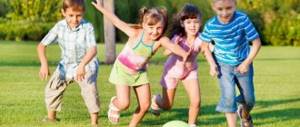Move
Only an even number of players take part in “The Third Wheel”, preferably 8 or more people. Before the start of the race, friends choose a “catch-up” or a driver and someone who will run away. The remaining participants are divided into pairs and stand one after another along the perimeter of the site, facing its center. The distance from one pair to another should be 2-3 m.
“Catching up” takes a starting position in the center of the court, and the runner stands behind the double ring of players. On command, the driver begins the pursuit. The “third wheel” is only allowed to move outside the circle; you cannot move away or run through it. Both active participants must not touch standing ones. If the “catch-up” hit the “third wheel”, they change roles.
The runner can stop moving and stand in front of any pair. Then he shouts: “Extra!” or “Run!” Hearing this, the player who was last in the column takes the baton.
During entertainment, the situation changes quickly, so everyone present must be ready to run away from the driver. Only two players can play acting roles. After everyone has tried their hand at running and practiced, the change of functions begins to happen very quickly. The pace of events increases, and catching up arouses greater interest among fidgets.
“Catching up” is forbidden to run inside the area, but he can harass the “third wheel” right on the spot, when he has not yet had time to start moving. If this happens, the children change roles and the game resumes.
The fun continues until everyone involved is tired of running. In one version of the game, couples do not stand still, but, holding hands, walk in a circle.
Variety of forms of play
Tags have several forms of play:
- “Tag games” (using various tasks) are catch-up games that develop running speed, coordination in space, dexterity and the ability to dodge.
- “Transition games” - actions move from independent leadership to group interaction.
- “Fishing in pairs, chains” - this variety teaches consistency in actions between participants and develops the team component.
- “Team” – when the actions contain an element of competition between full-fledged teams.
What else to read The oldest children's game or learning to jump over a rubber band
“Ordinary tags”
Among the participants, a “Driver” is determined, the rest of the team members are designated “Runners” and begin to move through the designated territory. The goal of “Water” is to catch up and touch one of the playing participants, after which the taunted player is automatically designated as a tag. The child who has been insulted raises his hand and says “I am a tag!”, starting to chase the rest of the participants in the game.
This game is endless, so you can initially agree on a time limit, after which they count who was the driver how many times. Whoever has the smaller number wins.
In the more complicated version, the successful player joins the already active driver, and together they catch the others. Each subsequent catch increases the number of drivers. The game continues until all participants in the game are caught.
Also, by agreement, some nuances of the game are allowed, such as:
- the leader should not touch those who insulted him;
- touching the arm, head and leg does not count;
- use of "houses" for recreation.
"Triple Tags"
The rules of the game remain the same, only the driver needs to touch the player three times, loudly saying “One, two, three!”
"Game of tag with salting"
One of the most famous options, where the newly acquired driver has the right to transfer the salt back. However, there is a possibility that the process may freeze in a confrontation between two people, when the remaining participants are inactive.
"Circle tags"
A circle is drawn on a flat surface around which the players stand. At the designated moment, the players must turn around and try to catch the fleeing participant. The person who is insulted is eliminated from the game. The winner is the one who was not caught up.
"Cross checks"
The player the leader is running after gets rid of the pursuer, provided that there is some participant between them. Then the driver will have to change the target, trying to catch the player who crossed his path.
"Chain tags"
The driver insults the player, grabs the insulted person’s hand, and the two of them begin to catch up with the other participants in the game. The next player caught, the sticky one, joins the waters.
A long chain is formed that catches players using the encirclement maneuver. The formed chain must not be interrupted. If the chain is disconnected, then one of those players who disconnected leads (selected by lot or counting).
"Peruvian salochki"
The essence of tag is that when the players hold hands, it is impossible to tag them. When the driver runs up to the target, the player must shout “Help!”, and someone nearby should run up and take his hand.
"Monkey-Style"
The most interesting version of the game is when the tag needs to imitate the actions of the running player. When “Water” approaches the player, he deliberately begins to perform ridiculous movements - running in single file, jumping on one leg, running down the street and making faces, and the driver repeats the movements after the target without interrupting the run.
If the driving player does not repeat the movements, then the shift is not counted, and the saved player is given a few seconds to run away.
"Salochki - the confrontation between civilians and vampires"
Participants consist of 2 teams. Of which some are “Humans”, and others are “Vampires”. Representatives of the human team have a distinctive symbol of fiery red color (ribbon, badge, bracelet, etc.). Monsters must kill as many “Peaceful” as possible; the game ends when the last enemy is caught. The huge advantage of the game is that there are no winners or losers - friendship always triumphs.
"Stinky" (Sifah)
The game requires an attribute (a ball, a black ribbon or any element that can be thrown safely, and in winter it can be a snowball), which the host throws at the players to make fun of them.
What else to read The edible-inedible game: fun options
If the attacker misses, he himself goes to remove the thrown attribute. The one who was hit is determined by the new driver.
“Sorcerers” (Tea - tea - help out or Freeze)
Participants are divided into 2 teams, most of them are “Runners”, one or more people are “Sorcerers”. The goal of the Sorcerers is to tarnish the members of the opposing team as much as possible. The player who has been “bewitched” must stop and freeze.
It can be disenchanted by a helper who is in free running. “Sorcerers” win if they have enchanted everyone, “Runners” win if they have not allowed their opponents to enchant everyone within a certain time.
A distinctive version of tag - you can play with it on skis in the winter, use the ice at a skating rink for playing, or play catch in the summer on roller skates
."Salki - Houses"
Before the game starts, determine the location of the “houses” where the game participants can hide. These can be outlined circles on the asphalt, placed hoops, jump ropes, elevated surfaces, folded hands above the head.
The driver catches up with the players who are fleeing to the designated place. However, it is forbidden to stay in the “house” for a long time, as is the driver to stay with the house for a long time.
A complicated version is considered to be the option when there is one less house than there are participants, and according to the conditions, it is forbidden for 2 participants to be in the same house. This allows participants in the race to show their speed and competitive spirit.
“Salki – legs in the air”
To avoid being caught by a driver, participants must remove their feet from the surface of the ground - climb onto an elevated place (curb, bench, playground).
"Salki - squats"
A lighter version of "Legs in the Air". You cannot insult a participant if he is squatting.
“Salka – hands behind your back”
If you are indoors or in a completely confined space, the “Hands Behind Your Back” version of the game is perfect. The driver's hands are tied behind his back (or he leaves them fastened in a lock), his goal is to touch someone with his hands behind his back. This option is difficult for the presenter and will require dexterity and ingenuity to upset at least someone.
"Tag on the table"
Two participants sit on opposite sides of the table. One participant places their hands on the table, palms down, while the other leaves them on their lap. The task of the one whose hands are not visible is to quickly cover the opponent’s hands with his own, the task of the first is to have time to remove them. In this case, a collective board game option is possible, subject to access to all participants.
"Salki - stand on one leg"
The players, together with the leader, move around the established territory, jumping on one leg. It is forbidden to change the leg until the driver changes. During the breaks between changing the tag, everyone rests, then everything starts again. If the driver stands on two legs, he is given a fine - to catch two players.
"Salka with two drivers"
Two drivers are identified. If one tag hits the runner, then only he changes roles with the latter, and the second driver leads until he touches another participant in the game.
"Salki - walls"
This type of catch-up can be used in schools during breaks - the “house” is a wall that you need to touch with any part of the body.
"Tag with a ball"
The main tag holds a ball in his hands, with which he tries to hit the running participants of the game. The main condition is that the ball must be thrown.
"Salki - give me your hand"
This tag perfectly develops mutual assistance and the ability to play in a team, because participants can only escape by taking the hand of another participant, forming a pair. If there is a chain of three or more people, the tag has the right to grease any of them. After the participants have escaped from the driver, they should remove their hands and run in different directions.
What else to read: A funny “Mousetrap” for the little ones
"Game of tag with driver substitution"
The tag participants line up. Then, through one player, they turn in the opposite direction, resulting in the children taking turns looking in different directions. After lining up, the players squat down. The first player standing starts first - chooses a direction and runs along the row, however, he can change the direction, running away from the driver.
The last player on the other side of the line is appointed as the driver; he can also choose any direction, but will no longer be able to change it. When trying to catch up with the target, the tag can change itself to another participant by touching the back of the squatting player and saying “Run!” Then the participant is replaced, and he himself chooses the direction of running, trying to catch up with the running player.
Tips for participants:
- To maintain the original diameter of the circle and not shrink it, couples should take a step back from time to time.
- If the new “third wheel” does not want to run around a lot, he can immediately stand in front of his neighbor or his own pair. The main thing is not to be greasy!
- When the catcher has run too fast and is tired after catching the next loner, he is allowed to join any pair and rest.
The dynamic game develops reaction speed, attentiveness, strength and dexterity. Thanks to her, friendships are strengthened, and more timid children get an excellent opportunity to express themselves and join the team. You don't need to buy expensive equipment to have fun. All you have to do is tell the children the rules and find a suitable area for running!
Cross Salki
An additional rule is introduced into the game. If the driver is chasing the runner, and another player crosses the road, the catcher must change direction and rush after him. Thanks to this, the dynamics of the process increases, and participants can help each other.
Outdoor play develops speed, dexterity and reaction speed. Running with catch-up is a lot of fun, so both kids and school-age children enjoy it.






